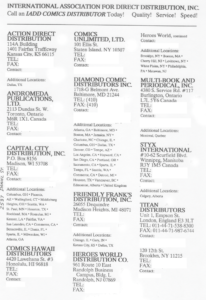Diamond Distribution files for Chapter 11 and Comic Books see the end of an era
by Man of the Atom
Introduction.
Thanks to Fandom Pulse, I found out that the last of the Direct Market Comic Book Distributors — Diamond Comic Distributors, Inc. — has filed for Chapter 11 bankruptcy protection. This is a great article at Fandom Pulse, summarizing the events and recent background, and its linked below. Please take some time to read it, then pop back over here if you want a bit more background on the Direct Market collapse.
Fandom Pulse: Diamond Comic Distributors Declares Bankruptcy
What does this mean for companies who still depend on Diamond to distribute their wares? Well, it’s find another channel, as did Marvel and DC, or shut the doors, or — maybe do something else to get their product to their readers.
Distribution of Periodicals: The Newsstand
I’ve talked about newsstand distribution in some of my previous posts. It was the way you distributed and sold any type of periodical, if you weren’t offering a subscription via the US Post Office. Pulp magazines, newspapers, glossy magazines, comic books, and all manner of periodically published printed materials could be sent by mail, if certain restrictions were followed.
For over four decades, newsstand distribution was the way comics found their way to the drug stores, candy and soda shops, grocery stores, book stores, restaurants, and darned near any other venue that wanted to engage with a periodical distributor. If the shop had a magazine rack, then they likely worked with a distributor.
Problem with the model was when it came to inventory. The producer of the periodical would get the returns of unsold merchandise, and you were only paid for what the retailer sold, not everything that you provided.
If the retailer didn’t sell all 10 issues of the magazine he ordered, the remainder could be returned to the distributor for a future credit on upcoming purchases. This wasn’t a huge issue until the Thor Power decision of 1979/1980. That eliminated a tax break that publishers received on their inventories of back catalog materials.
Even before this event, publishers wanted another channel to get books to customers. Additionally, the collectors market was growing due to fan interest and fan publications such as Jerry Bails “The Who’s Who of American Comic Books”. In 1978, the Direct Market was created to address some of these issues.
Direct Market: Take All You Want Comes to an End
As discussed in a previous post, the Direct Market addressed some of the issues that publishers had with the Newsstand Distribution Model, specifically, the returned inventory. Under the Direct Market, the retailer ordered a specific number of copies of a comic book issue, as under the Newsstand Model, but now if the retailer ordered 10 and only sold 7, the retailer kept the remaining 3 issues. No returns.
Direct Market vs Newsstand: What’s the Difference?
The structure of the Direct Market made it very difficult for small retailers to order comics for their shops because they rarely had the storage space for unsold issues. The comic book was also a loss leader for most businesses, as it was likely more a secondary sale to children who accompanied their parents for other business in the store. The Newsstand distributor who brought new books and took old ones back was likely the favored option for these folks. Why do I say that? Because when comics vanished from the Newsstand distributors, they vanished from the landscape of the small retailer who was not a dedicated Local Comicbook Shop (LCS).
For the LCS, the Direct Market was a solid model. Regular customers would get orders in for their books and the owner would build a list of books to send to his Direct Market distributors.
Yes, that is distributors with an “s”.
Take a look at a snapshot of the International Association for Direct Distribution Inc., circa 1991. Eleven distributors of comic books and comic book-adjacent materials.

With the option to have the Direct Market, Newsstand Distribution, and Postal Subscriptions, it would appear that the publishers, retailers, and comic book readers should pretty much have it all, right?

Jim Shooter Takes a Stand and Pays for It
Jim Shooter was working at Marvel Comics as its Editor-in-Chief from 1978 to 1987 when he was fired. His termination was partly because he recognized that Newsstand Distribution was an important component of the Comic Book business along with Direct Market distribution methods. Others in the company believed Direct Market was the only profitable route for the company to take.
Let’s tune in to Mr Shooter’s reasoning, excerpted from his excellent though long-abandoned blog:
Interestingly, the Direct Market did not seem to be cannibalizing the newsstand market.
Don’t get me wrong, the newsstand market was limping along around breakeven. I wrote about that HERE. But, it had been going like that before the advent of the Direct Market. And, it was nonetheless accounting for the great majority of comics sold.
What seemed to be happening was this: The Newsstand market, with its many tens of thousands of outlets (around 75,000, I think) served by the 400+ ID Wholesalers in North America was continually bringing in new readers. Some of them became enthusiasts and found their way to the comics shops. But new newsstand buyers kept turning up to replace them.
Titles like G.I. JOE, Transformers and Star Wars helped attract new readers at the newsstands. Most people, especially kids, didn’t know or care who Iron Man was, but every kid knew G.I. JOE. Sooner or later, a kid with a Snake Eyes figure in his pocket was bound to pass a spinner rack somewhere.
The newsstand cast a wide net. It funneled wannabe collectors into the comics shops. In a way, the spotty, unreliable, inconsistent nature of newsstand distribution was a good thing, because someone who just had to have every issue was more or less forced to seek out a comics shop.
Link for the above quote is here — Comic Book Distribution – 03.
Shooter recognized that despite the lackluster sales of the Newsstand Distribution it did several things for Marvel Comics and comics in general:
- Wide-net Marketing.
- Introduction of new readers to the world of comics.
- Cross-platform marketing, e.g. toys + comics, movies + comics, etc.
- Feeder for Local Comic Shops.
Long to short, Shooter lost the battle to keep Newsstand Distribution at Marvel, and shortly thereafter, was terminated from the company in 1987. Read more about Comic Book Distribution at the link above and at these two follow-on links. Shooter’s awareness of both marketing and distribution of comics came from work at both National Periodicals (DC) and Marvel Comics between 1966 and 1987.
Comic Book Distribution – 01
Comic Book Distribution – 02
But, let’s not leave until we cap off the discussion with the loss of subscriptions. Marvel clearly threw all its eggs into the Direct Market basket early in the game. DC would follow this path as well, but they hung onto their subscription channel until 1999. The sad fact is one of the reasons that they abandoned it was the LCS demand for it to cease, in order to pull in those revenues to make up for deteriorating sales at retail. The effect on profits was likely negligible, but it again cut off the comic readers who didn’t have ready access to an LCS.
For comic books, the late 80s and the 90s were an era of eating your seed corn with a shovel.
The Heroes World Debacle
Run forward to 1994 at Marvel Comics. DC’s 1992 “Death of Superman” series, while initially profitable, had killed the readers’ trust in “stories actually matter in continuity” for both Marvel and DC. Sales began to falter in 1993 and 1994. Ron Perelman, then the CEO and owner of Marvel Comics, took steps to buy Heroes World, the third largest comic book distributor, to be the exclusive distributor for Marvel Comics.
This led both Diamond and Capital City, the #1 and #2 distributors, to attempt to become the exclusive distributor for every other comic book company. The sale to Marvel went through, Heroes World became the exclusive distributor of Marvel Comics, and failed miserably. So miserably that by 1997, Heroes World was dead and gone and Marvel Comics had filed for — wait for it — bankruptcy protection.
Not only was Heroes World gone, but because Marvel Comics made up between 30-40% of all comic book distributors’ inventories, all the other comic book distributors went out of business as well.
Except for Diamond.
Check out a short series of web articles by Chuck Rozanski on this comic book burn-down by DC (Death of Superman) and Marvel (Heroes World) due to ignorance, arrogance, malfeasance, and outright greed.
Diamond Distribution: Lord and Master of All They Survey
As with most monopolies, most didn’t like the landscape presented by the new boss, Diamond. Their catalog only had so much space, so Marvel, DC, Dark Horse, and some larger Independents received the right of first booking, leaving smaller Indies struggling to get their books into the LCS channels, sort of driving around and begging an LCS to carry their books.
As LCS sales of comics continued to lag from the late 80s through the 90s, more shops carried figurines, posters, toys, and other higher margin materials in their stores, again turning the comic book into a kind of “loss leader” in the shop. The collectors market was hot-and-cold, but ancillary sales of comic book related materials became a mainline sales item.
So, Diamond expanded their distribution into these areas as well, reducing the solicitation space for Independents even further.
Digital Domination: Whither the Comic Book?
It hard to say what will come next for a number of comic book companies if they don’t find another distribution channel, and relatively soon. The Penguin-Random House channel might be big enough to accommodate all these folks listed below.
But, what about these guys? Where do they go to distribute their comic book-related games, collectible card sets, character figurines, posters, toys, slipcases, comic book bags and boxes, and a host of other supplies? Who is going to ship and move all this stuff to the consumers?
“2500 new titles and products”
“hundreds of leading publishers and manufacturers”
This is gonna sting unless your company has been planning for it and is out ahead of this issue.
And let’s not forget the Local Comicbook Shops. Already on hard times over the COVID slap, this will likely winnow away another huge swath, leading to even fewer comic book readers on the horizon. The knock-on effects are going to be interesting, to say the least.
What’s next?
Really good question, and here I am without a pat answer. Solutions will be found by the people who really want to make comic books in these times.
Digital distribution is a thing. Fundraising sites and Neo-patronage sites exist and are successful for some creators. Setting up a store via Amazon, eBay, Lulu, and other venues is possible. You can even set up a personal store on your own home-built website.
Looks like another great opportunity for the Independent with a will to win to see if he can create the next great event for an entertainment medium.
Will comic books survive?
Dunno. But, I’ll be sticking around to find out, one way or another.
Thanks for reading!


